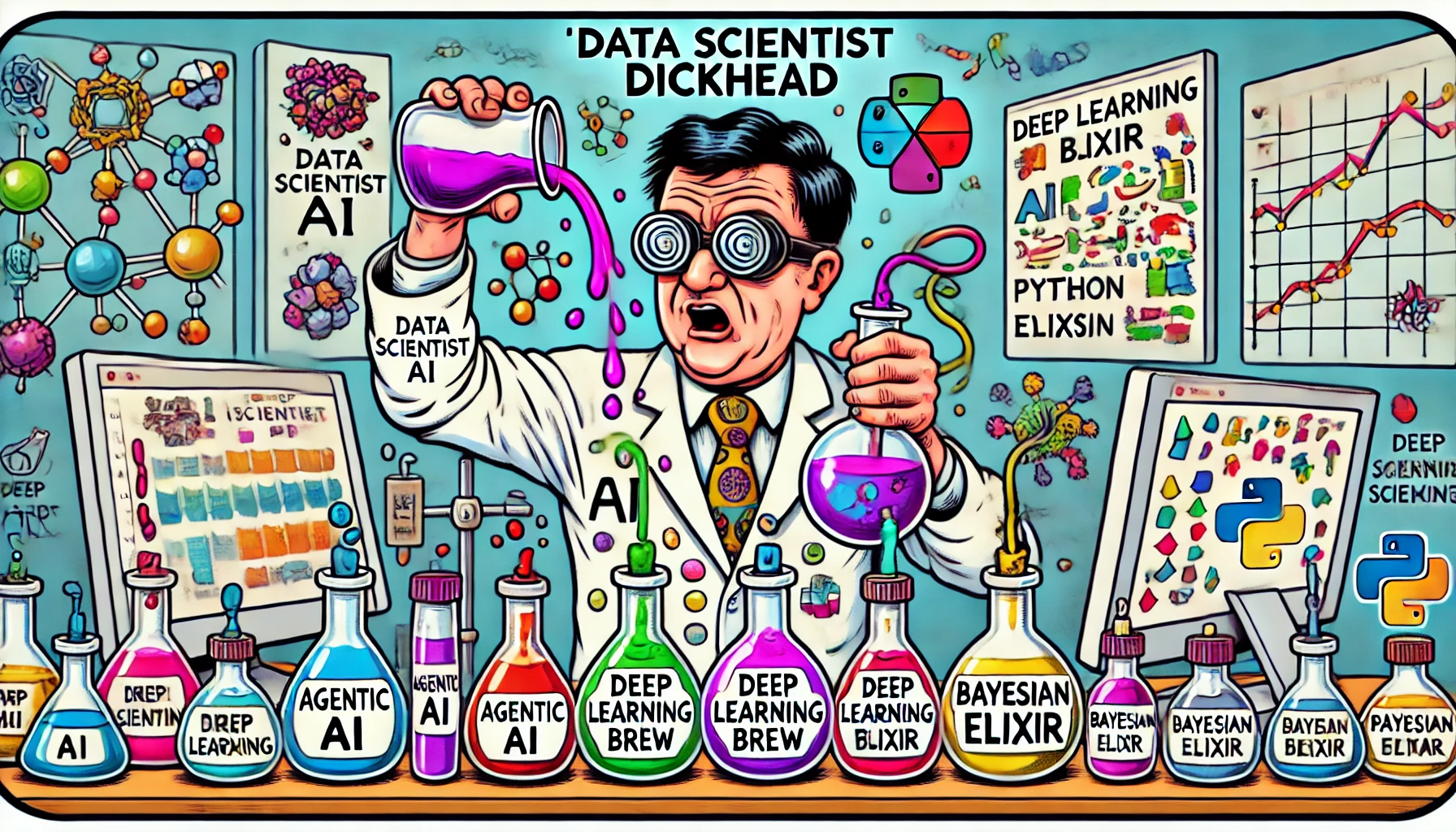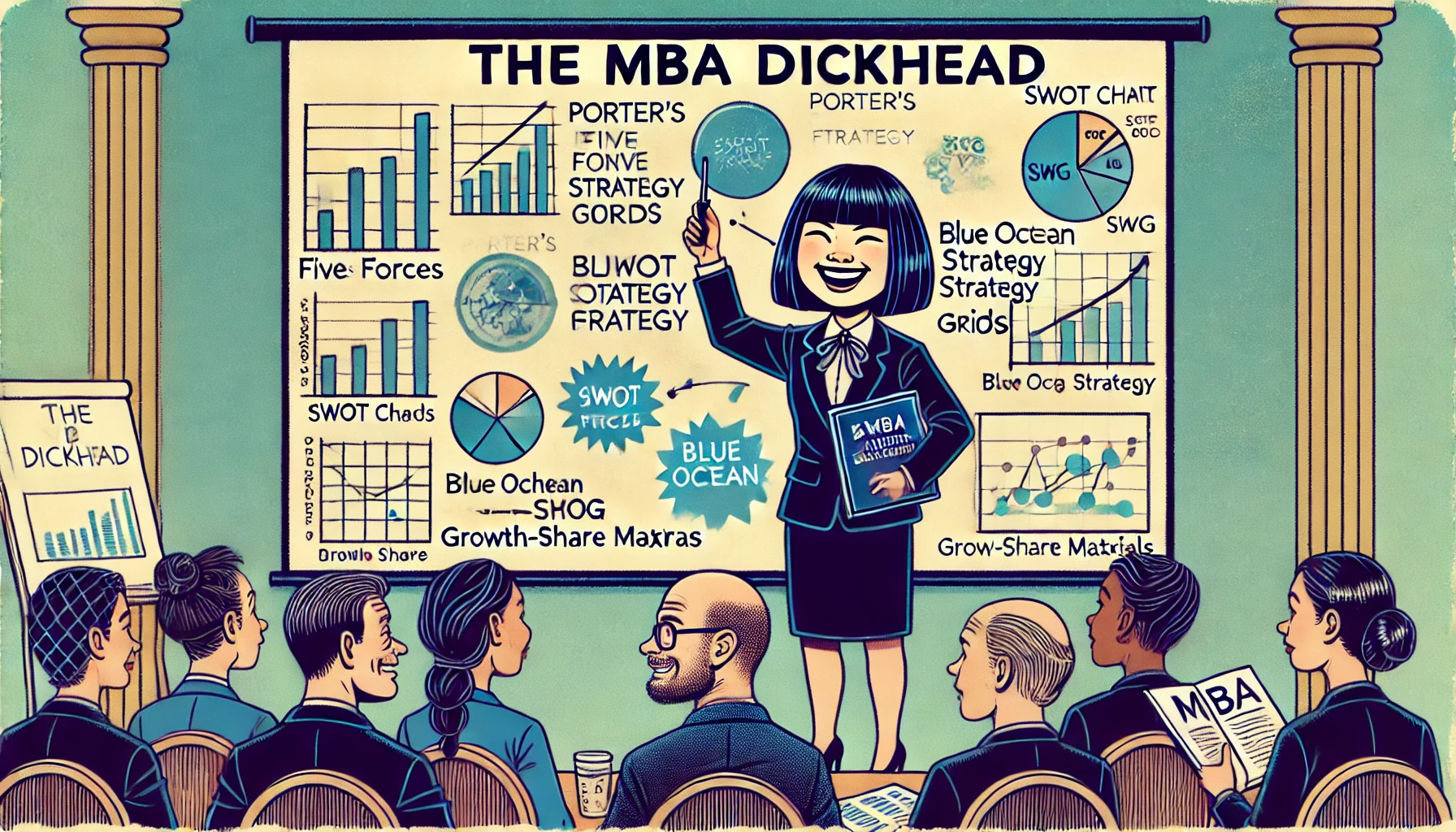1. Definition:
The Data Scientist Dickhead is not your run-of-the-mill data geek – this is a once-forgotten data analyst reborn as an “AI Oracle” thanks to the corporate hype around AI, data lakes, and machine learning. Once upon a time, they toiled in obscurity (probably in a back-office cubicle next to the server room), but now every executive treats them like a walking, talking crystal ball of analytics. Their focus has nothing to do with business results and everything to do with proving their intellectual superiority. Revenue, sales, ROI? Boring! What truly matters is racking up more academic publications and patent applications than their peers. The company has practically strapped them into every meeting – from strategy sessions to sandwich budget discussions – just in case someone utters the phrase “AI use case,” upon which they can dramatically clear their throat, ready to descend from the heavens of jargon.
2. Parody Scenario:
A Day in the Life of the Data Scientist Dickhead:
Morning: An eager manager pops in with a straightforward question: “Hey, do we know why website traffic dipped yesterday?” Our Data Scientist Dickhead adjusts their glasses and refuses to give a simple answer. “The data pipeline lacks robustness for statistical inference,” they declare, insisting that nothing can be answered without a six-month research project. Instead of a yes-or-no or a quick insight, they propose forming a task force to completely rebuild the data lake, run a Bayesian analysis, and perhaps simulate the scenario on a quantum computer – just to be sure. By the time they finish explaining the “insufficient rigor” of the question, the manager has forgotten what they even asked in the first place.
Mid-Morning: In the executive meeting, while people discuss quarterly earnings, the Data Scientist Dickhead seizes the moment to launch into an unsolicited deep-dive on Bayesian probability. One executive innocently mentions uncertainty in the sales forecast, and that’s the Dickhead’s cue: “Allow me to explain the Bayesian updating of our prior assumptions,” they interject, pulling up a makeshift whiteboard. Ten minutes later, the entire room is staring at a convoluted tree of probabilities and Greek symbols that has absolutely no bearing on any decision at hand. The CEO and VPs exchange nervous glances – nobody has a clue what’s being discussed, but each is too afraid to admit it. There’s awkward silence followed by polite nodding, as if derailing the meetinginto statistical la-la land was completely normal. (Secretly, half the room is wondering if it’s too early for lunch or a stiff drink.)
Lunch: Having thoroughly confounded the executives, our hero corners a high-ranking VP in the cafeteria buffet line. The VP was just trying to grab a sandwich, but now they’re clutching a tray while the Data Scientist Dickhead holds court about “agentic AI”. With wild eyed enthusiasm, the Dickhead describes a future where AI manages the company, the markets, possibly the world – all delivered in a tone that suggests we’re already late to the party. The VP, mid-bite and wholly out of their depth, hears phrases like “self-supervised agent” and “autonomous revenue optimization agentic networks.” In a mild panic (and not wanting to appear clueless), the VP hurriedly agrees to green-light a million-dollar AI initiative on the spot. By the time lunch is over, leadership has been terrified into funding an ambitious-sounding “AI Transformation Program” that no one really understands – except, of course, our Data Scientist Dickhead, who is already envisioning the glossy research paper that will come out of it.
Afternoon: Fresh from securing new funding, the Data Scientist Dickhead proceeds to demand access to “all company data.” And by all, we mean ALL – customer databases, sales logs, HR records, the CEO’s Fitbit data, last year’s cafeteria menu, everything. They announce this in an email with at least five buzzwords per sentence: “To build a holistic AI model, I require a synergistic integration of all data silos into our pipeline for a proof-of-concept.” The IT department nearly chokes – this person basically wants the keys to the kingdom. When someone meekly asks “Um, what is this proof-of-concept going to do?” the Dickhead rolls their eyes and mutters something about “leveraging deep learning to disrupt legacy paradigms”. Everyone just nods (again) and grants them access, knowing full well this grand experiment will likely never move beyond an 800-GB Jupyter notebook. But hey, it will look fantastic in the research paper they’re writing about it!
Evening: While the rest of the company struggles to finish a simple dashboard for actual business needs, the Data Scientist Dickhead is burning the midnight oil – not to deliver actionable insights, of course, but to publish a paper. Titled something like “AI-Driven Revenue Maximization: A Multivariate Approach to Hyperparametric Profit Functions,” the paper is uploaded to arXiv and blasted on LinkedIn. It’s filled with lofty promises of improving KPIs by 10x using AI (never mind that nothing has actually been implemented at the company). The Dickhead adds “Co-Inventor” on a newly filed patent to their email signature for good measure. By the time the janitor comes around, our Data Scientist Dickhead is basking in the glow of intellectual accomplishment, utterly unbothered that the original business question from the morning still hasn’t been answered. After all, who cares about a measly daily metric when you’ve got academic glory to chase?
3. Why They Exist:
The Data Scientist Dickhead exists thanks to a perfect storm of corporate desperation and personal ambition. Think of them as exiled academics finding salvation in the boardroom. Many of these folks were once PhDs or researchers who languished in corporate obscurity – the kind of brainy employee exiled to the basement of Finance or Operations, crunching numbers nobody looked at. They spent years indulging in esoteric projects and begging someone (anyone!) to care. Enter the AI hype. Suddenly, the company’s leadership decides “We need AI on everything!” and voilà – the long-ignored data nerd is resurrected as an indispensable guru. This is corporate validation on a scale they only dreamed of; overnight, their quirk for over-complication transforms into a high-demand skill.
Now the company drags them into every meeting, every email thread, every coffee break, just in case an “AI use case” might be hiding under the table. They thrive in this environment because, truth be told, no one else in the company really understands this stuff, so nobody can confidently challenge them. It’s the ultimate revenge of the nerd: the same person who once got shooed away for bringing up neural networks at a budget meeting is now getting standing invitations to discuss “strategic AI alignment” with the C-suite. They exist because companies fear missing out on the Next Big Thing – and who better to champion that thing than someone who speaks fluent Technobabble? In short, the corporate world created this monster by collectively nodding along to jargon in hopes of striking innovation gold.
4. How to Spot One:
So, how do you know if you’ve got a Data Scientist Dickhead on your hands? Watch for these telltale signs:
- Analysis Paralysis Presentation: They will not answer any question without cracking open a Jupyter Notebook, presenting at least three indecipherable graphs, and adding a footnote about statistical significance. (Ask them the time, and you’ll get a lecture on the confidence interval of the clock.)
- Dashboard Disdain: They claim that anything as straightforward as a PowerBI dashboard is “not real data science.” If it isn’t coded in Python with a custom machine learning model, they dismiss it as child’s play.
- Data Hoarding Syndrome: No matter how much data you already have, they insist on collecting “more data.”Got a perfectly good 5-year dataset with thousands of records? “It’s not enough,” they’ll say. The existing dataset is never clean or complete enough in their eyes – they’d rather boil the ocean and then some.
- Jargon Overload: They drop AI terms nobody in the room understands, then smirk when everyone nods along in confusion. You’ll hear them casually mention “stochastic gradient descent tuning” or “agentic transformer synergy” in a discussion about, say, marketing spend. The more blank the stares, the more satisfied they become.
- Title Inflator: They refer to themselves as an “AI Researcher” or “Machine Learning Scientist” at every opportunity – despite never having built a single working product. Their LinkedIn job title has more buzzwords than an MIT syllabus, but ask them to point to a live AI solution their work produced, and you’ll get an awkward silence (or another paper reference).
5. How to Deal With Them:
Dealing with a Data Scientist Dickhead is its own art form. Here’s a hilarious survival guide with tactics to keep their ego in check and your sanity intact:
- The “Just Give Us a Yes or No” Maneuver: When you need a straight answer, refuse to be drawn into their data labyrinth. Prompt them firmly for a simple yes-or-no answer on the spot. Example: “Great, but before you run off to build a model, can you just tell me yes or no, will this campaign lift sales?” This forces them out of analysis-paralysis mode. Watch as they squirm – answering without a multi-page report feels like trying to walk without a PhD – but eventually, they’ll cough up a plain answer (however painful it is for them).
- The “Business Relevance” Interruption: The moment they drift into an AI tangent, politely cut in with a reality check: “Fascinating stuff, but does this actually help us sell anything or improve a KPI?” Deliver it with a friendly smile. This question is kryptonite to their academic ramblings – it yanks them back to planet Earth (Business Edition). Suddenly, all the fluffy talk of Bayesian-this and neural-that has to justify its existence. It’s a polite way of saying, “Cool theory, bro, but what’s the ROI?” and it often leaves them momentarily speechless as they recalibrate to find a business point.
- The “Let’s Get This in PowerPoint” Trick: If they’re spewing jargon at full throttle, disarm them by cheerfully suggesting, “Could you summarize that in a PowerPoint slide with three bullet points? We’d love to follow along.” Nothing terrifies a Data Scientist Dickhead more than the prospect of condensing their 30-minute grandiose monologue into three succinct bullets for mere mortals. It’s the ultimate buzzkill for their buzzwords. You’ll witness their will to continue evaporate as they stammer something like, “Well, it’s a bit more complex than can be put in three bullets…” Exactly. Mission accomplished – you’ve effectively hit the pause button on the jargon firehose.
In conclusion, the Data Scientist Dickhead can be equal parts amusing and exasperating. They’re the product of our times: born of big data buzz, raised in the wilds of academia, and unleashed onto hapless corporations riding the AI tidal wave. Ridiculous as they are, you have to admire the sheer audacity – and maybe take comfort in the fact that with a few smart tactics (and a good sense of humor), even the mightiest of jargon-spewing “AI Oracles” can be kept in check. After all, at the end of the day, even the biggest Dickhead still has to answer the one question they hate most: “So what real-world result does this actually deliver?”



